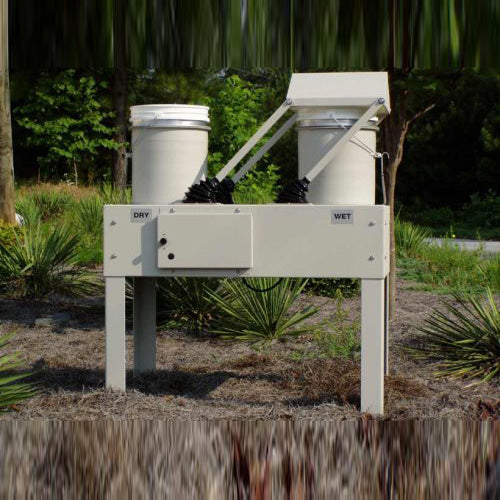
Model APS Acid Precipitation Sampler
Description
Modern pollutants including sulfur dioxide (SO2) and nitrogen oxides (NOx) combine in the atmosphere with water vapor and return to the environment as sulfuric (H2SO4) and nitric acids (HNO3).
These acids dissolve in cloud droplets and raindrops, forming acid rain. Natural sources contribute to the acidity of rainfall. However, in recent times, automobile and industrial pollutants have increased the acidity of rainfall in certain areas to problem levels. Strong and shifting winds can transport acid rain pollutants hundreds or thousands of miles from the source of emission, distributing them over large geographical areas.
New Star Environmental has met these sampling needs with the Model APS (Acid Precipitation Sampler), the standard of quality in atmospheric precipitation collection. The APS is designed to collect precipitation in two containers – one container is open only during precipitation and the other container remains open between precipitation events. This allows dry deposited material to be collected. A specially designed sensor detects precipitation and activates a motor, which in turn transfers a cover from the wet container to the dry container. When the precipitation event is over the cycle is reversed. The most outstanding features of the APS are the simplicity of design, reliability of the operating components and the quality of materials that are designed to give years of trouble-free operation.
The Model APS accurately separates and collects both total precipitation and total dry particulate deposition for later laboratory analysis of pH, conductivity and specific ions.
The Model APS allows for accurate collection of precipitation samples with a minimal amount of downtime. The Model APS is designed for severe environments with a main frame constructed of polyurethane coated, heavy gauge aluminum. The two symmetrical collectors have a common gabled roof cover with an internally sealed surface.
All electronic components of the Model APS are readily accessible, so that repairs can be made in the field. A recording elapsed time indicator is included as standard equipment on the APS. This indicates the total amount of time that the collector is available for service during any time period. An on / off indicator light is provided for visual inspection and a cycle counter has also been designed to record the number of open / closed cycles during any time period, thereby recording the number of precipitation events.
The Model APS is comprised of four major functional systems:
- Sensor – A rugged sensor system detects precipitation episodes and activates the cover drive mechanism to seal the dry deposition collector and expose the wet precipitation collector. When the precipitation ends, the heated sensor dries rapidly and activates the cover drive mechanism to seal the wet collector until the next episode.
- Control – The control system consists of a high input impedance schmidt trigger and a relay driver. Sensor output is connected to the input of the schmidt trigger. A very small oven causes the trigger to switch on the relay driver. The trigger resets on the absence of a signal.
- Drive – The drive system consists of a 12 volt motor driven ram linear screw actuator developing a load rating to 250 pounds (113 kg), a four-bar linkage and two limit switches.
- Sample Collectors – The collector system segregates dry and wet samples. This segregation is coordinated by the sensor, control and drive systems.
Specifications
| Collector Size | 3 Gallon Buckets |
| Dimensions, L x W x H | 21 x 40 x 50-inches (52 x 101 x 128cm) |
| Electrical Requirements | 110VAC/60Hz, 12VDC or 220VAC/50Hz, 12VDC |
| Weight | Net - 127 pounds (58kg); |
